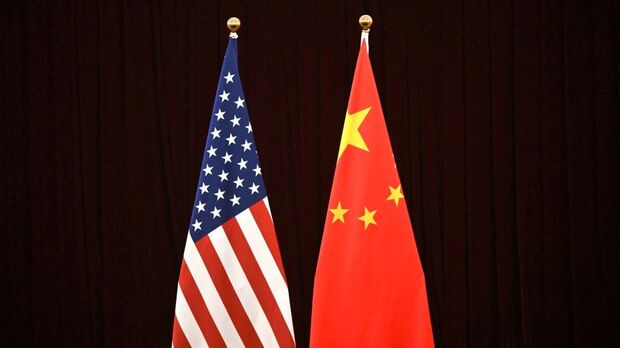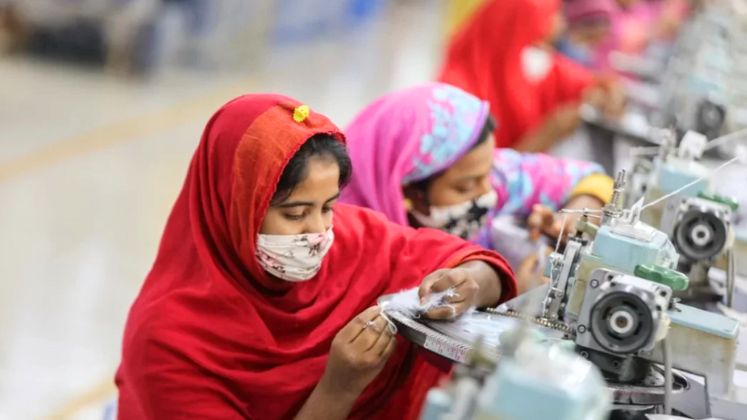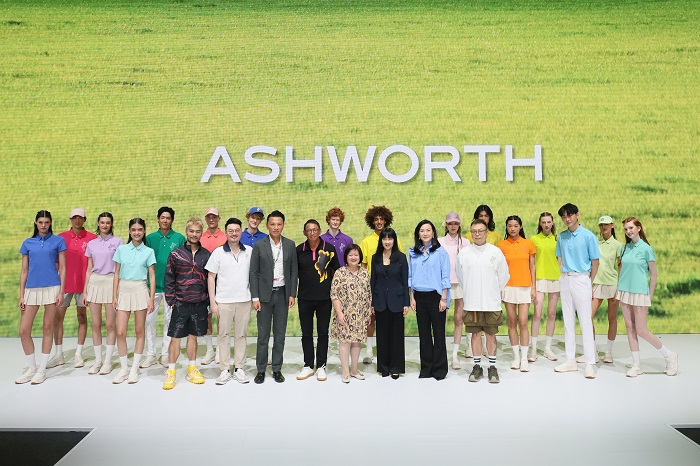FW
After dropping slightly in July, apparel imports into the US recovered in August, increasing 1.6 per cent. The recovery was primarily due to an increase in imports of capital goods, consumer goods, and industrial supplies and materials. A rise in travel and transport also helped boost imports.
China, Vietnam, Bangladesh and Indonesia were the top sources of US apparel imports in July. Imports from Vietnam grew 20 per cent over June of last year, while those from China fell by 2 per cent.
On a 12-month smoothed basis, however, which corrects for volatility of data in a particular month, apparel import growth slowed to 2 per cent in August, its slowest monthly rate in over a year, an indication that apparel import growth will be slowing in the coming months.
Apparel exports rose 4 per cent, on top of impressive 6 per cent gains in both June and July, and slightly outpacing overall goods and services export growth of 3.9 per cent. On a 12-month smoothed basis, apparel exports accelerated by 4.3 per cent in August, even with July.
Canada is the biggest market for US apparel exports, followed by Mexico, the UK, Japan and Honduras. Apparel exports to El Salvador have grown 15.2 per cent so far this year and to Chile by 13 per cent. Exports to Germany have grown by 8.5 per cent while those to the Netherlands have dropped by 8 per cent.
Messe Frankfurt Argentina has taken over the international Emitex, Simatex and Confemaq trade fairs, which cover the fields of textile and garment machinery as well as the textile and garment industry.
Thus the company has expanded its portfolio of fairs and reinforced its position as the world’s leading organiser of fairs for this market.
Itsportfolio of textile fairs embraces over 40 international events and covers the entire textile value chain. By taking over the three trade fairs, it can now offer customers easier access to the growing South American textile and garment market. The company has been operating successfully in Argentina for 15 years.
Emitex, Simatex and Confemaq rank among the biggest international events for the textile and garment industries in South America.Messe Frankfurt Argentina, a subsidiary of Messe Frankfurt GmbH, has been organising events in Buenos Aires since 1999.
As part of the Messe Frankfurt portfolio of textile fairs, Emitex, Simatex and Confemaq will be integrated into the company’s technical textiles andtextile processing business unit.
The Argentinean textile and garment industries grew by around 70 percent in total with 5.5 percent per annum over the last 12 years. A large part of the country’s textile and garment exports goes to Brazil and Chile while China and Brazil are the biggest supplier nations.
https://www.messefrankfurt.com/
India's cotton and apparel exports are set to climb by around 10 per cent this year.Higher wages, political instability and concerns about workplace conditions in other markets like Bangladesh are steering international buyers toward Indian exporters.
The rise in textile shipments from India — currently around 4.5 per cent of world trade — may eat into top exporter China’s 36 per cent share of the market and will be a boon for Indian textile merchants keen to exploit rising demand stemming from weak cotton prices and global economic growth.
Aside from stronger global demand, larger domestic cotton supplies will also help India push textile and apparel exports up by about 10 per cent in 2014-15. The main markets for Indian textiles at the moment are the United States and the European Union. Expansion in domestic demand is also likely, with India’s local textiles market expected to grow in the coming years.
But while exports are expected to rise from India, China, with textiles and apparel exports worth 270 billion dollars, around seven times that of India’s receipts, is expected to remain the dominant player.
India’s relatively poor infrastructure, wobbly energy supplies and lack of a business-friendly environment for both foreign and domestic investors are expected to constrain overall export growth over the near to medium term.
The China International SME Fair 2014 (CISMEF) will be held this month.The fair would provide exposure to 1.1 million small and medium enterprises of the world. CISMEF 2014 would be creating a number of new export opportunities for various items produced in the local SME sector. Especially items belonging to handicrafts, horticulture, food and textile sectors would be able to obtain adequate orders for long-term export trade at this fair.
CISMEF has successfully held ten editions since 2004 and attracted over 20,000 exhibitors and 1.1 million visitors from around the world.This is the largest SME fair in the Asia Pacific region. It consists of two parts: the themed show and the specialized show. The commodity trade show consists of a machinery products exhibition zone, a jewelry and craftwork exhibition zone and a green food exhibition zone.
The theme of this year's CISMEF is Energy Conservation, Environmental Protection, Green and Low Carbon. The exhibition space is over 1,00,000 square meters with 5,000 booths.
CISMEF is not only a window for Chinese SMEs to learn about the world, but also a bridge for the products and services of international SMEs to enter the Chinese market. Every year it embraces nearly 5,000 exhibiting enterprises from 31 provinces in mainland China and over 20 foreign countries, attracting 2,00,000 visits each year.
Cambodia's economic growth is estimated to reach 7.2 per cent this year, driven by garment export, construction, and services sectors.Growth has held up well in Cambodia despite domestic uncertainty and instability in neighboring countries. Overall macroeconomic management has been good, with fiscal consolidation underpinned by improved revenue administration.
With the expectation of renewed confidence and the return of political stability after ending a yearlong political deadlock in July 2014, bolstered by a strengthening global economy, Cambodia's real economic growth rate for 2015 is expected to improve further, achieving 7.5 per cent.
The downside risks to forecast growth are potential further labor unrest and the high seasonal floods as well as regional political uncertainty.Garments continued to be Cambodia’s key engine of growth, while construction overtook the decelerating tourism and crops sectors as the second most important growth driver.
The country has made good strides in improving maternal health, early child care and primary education programs in rural areas. Poverty has fallen sharply. However the vast majority of families who escaped poverty were able to do so only by a small margin. About 90 per cent of them live in the countryside.
Cambodia still faces a number of development challenges, including effective management of land and natural resources, environmental sustainability, and good governance. Corruption and weak public service delivery impede inclusive development. The key challenge going forward is to stimulate the agricultural and tourism sectors to once again become strong engines of growth supporting poverty reduction, as well as to expand and sustain growth in manufacturing including garments.
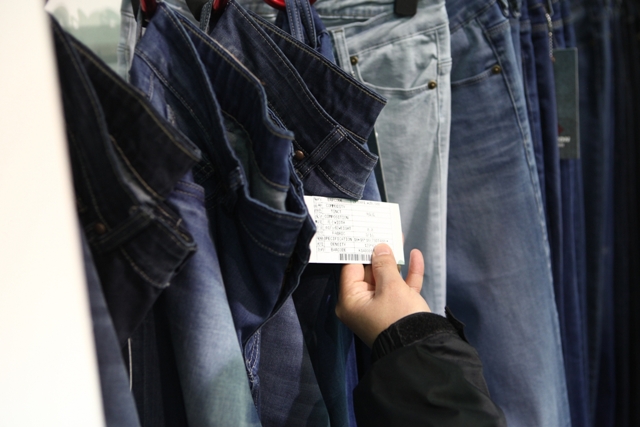 Autumn 2014 edition of Intertextile Shanghai Apparel Fabrics to be held at Shanghai New International Expo Centre in Shanghai, China, from October 20 to 23, 2014. Exhibition will see a newly designed Beyond Denim hall with increased capacity to meet the domestic demand.
Autumn 2014 edition of Intertextile Shanghai Apparel Fabrics to be held at Shanghai New International Expo Centre in Shanghai, China, from October 20 to 23, 2014. Exhibition will see a newly designed Beyond Denim hall with increased capacity to meet the domestic demand.
Beyond Denim gets bigger & better
This year’s fair will boast 15 halls, with over 3,800 international and domestic exhibitors featured across more than 170,000 sq. mtr.of space.Following the success of last year’s denim zone, the newly designed and enlarged Beyond Denim hall will feature around 150 exhibitors from six countries and regions. In China, the latest denim products are increasingly popular as China’s expanding middle and upper classes follow western fashion trends.As a result, this year’s denim area expands to an entire hall witnessing a 25 per cent increase in exhibition space compared to last year.
This presents an exciting opportunity for overseas companies to take advantage of this  lucrative market. And the new design of the hall created by renowned French studio, the NellyRodi Agency is expected to attract more buyers to the area. Some of the highlights on display this year include examples of new wash innovations, the latest technologies, sustainable production practices and premium denim in Beyond Denim Forum.
lucrative market. And the new design of the hall created by renowned French studio, the NellyRodi Agency is expected to attract more buyers to the area. Some of the highlights on display this year include examples of new wash innovations, the latest technologies, sustainable production practices and premium denim in Beyond Denim Forum.
The expanded hall gathers most of the leading domestic denim manufacturers, denim designers and marketing firms, as well as international denim fabric exhibitors. TextilSantanderina SA is an exhibitor from Spain that believes their high-end Spanish products will do well in the Chinese market. Their collection includes faded finishes, new digital prints inspired by nature and poetry, cotton/Lycra and 100 per centTencel fabrics, and jacquard styles inspired by a Bohemian soul and the spirit of old cities that leads to rustic, textured, delicate and aged looks.
American &Efird is another well-known supplier from USA. They will introduce premium products following the hottest trends in the market for denim wear and active wear. According to the company, denim is a traditional ‘must-have’ item for consumers which, therefore, demands high quality threads to safeguard seam integrity. Their major products include corespun threads with NWT technology and textured threads which incorporate quality trims.
Intertextile Shanghai Apparel Fabrics is co-organised by MesseFrankfurt (HK); the Sub-Council of Textile Industry, CCPIT; and the China Textile Information Centre.
There is a growing trend of orders shifting from China and Bangladesh to Vietnam.Multinational groups have realized that outsourcing in China is no more the optimal solution. Production costs in Vietnam are obviously lower than in China. A Vietnamese worker earns half of what a Chinese worker earns.
Brands have been scaling down production in China while expanding in Vietnam. The largest technology groups of the world have also poured billions of dollars into their production bases in Vietnam, though they also have large scale factories in China.
The percentage of Japanese enterprises in China planning to scale up production in China dropped from 73 per cent in 2010 to 57 per cent in 2013. Meanwhile, the figure increased from 27 per cent to 30 per cent in Vietnam.
From humble beginnings since the reunification of its northern and southern regions, Vietnam has become a strong player in the global textile market. State-owned enterprises make up just 0.5 per cent of Vietnam's businesses; however, 75 per cent are joint stock or limited companies.
Vietnam has advantages: only small investment capital required; a quick payback period because of short capital turnover; and lots of preferential policies from the state.
The Transatlantic Trade and Investment Partnership (TTIP) is a proposed free trade agreement between the EU and the US.This is a deal involving the world’s two biggest economies.
Some say the agreement would result in multilateral economic growth and raise incomes in the EU and the US. While some say it would increase corporate power, is an agenda driven by international business that threatens environmental, health and safety standards and would make it more difficult for governments to regulate markets for public benefit.
Among the issues raised are labeling requirements over the care instructions, the fiber names disclosed in a garment composition label and the use of the super S scheme for the labeling of wool products.Concerning consumer safety requirements, the European industry raises questions on children’s products and on flammability requirements that apply to clothing and other textile products such as home textiles and personal protective equipment.
TTIP will help unlock opportunity for American families, workers, businesses, farmers and ranchers through increased access to European markets for American made goods and services. It is a cutting edge agreement aimed at providing greater compatibility and transparency in trade and investment regulation while maintaining high levels of health, safety, and environmental protection.
Bangladesh has announced incentives for jute exports to India.However jute mills in India are not amused. They are planning to file an anti dumping case. They feel such subsidized exports to India from Bangladesh will hurt the Indian market.
Bangladesh has been offering 10 per cent export subsidy on all jute products. The country’s jute mills and exporters receive 40 per cent and 20 per cent of their fund requirement, respectively, from government banks. Also, China is collaborating with the Bangladesh government to fund modernising initiatives for 23 jute mills.
Meanwhile, Indian jute exporters are facing stiff competition. During the April-September period this year, the volume of exports fell 11 per cent compared to the year-ago period. In recent months, exports have fallen due to higher exports by Bangladesh and instability in West Asia, a major market for Indian jute exporters.
Indian mills say imported jute bags and jute cloth are being used to package food grains, a violation of the Jute Packaging Materials Act , 1987. Between April and August this year, the import of jute yarn and twine increased 65 per cent year-on-year. Import of jute bags was up 28 per cent and jute cloth and related products seven per cent.
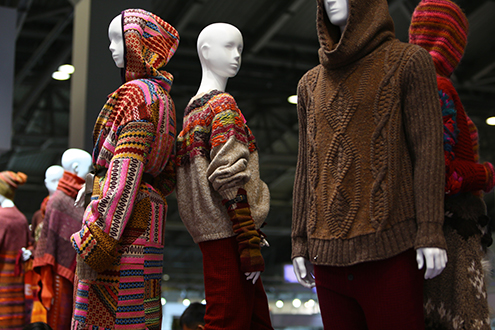 Spinexpo Shanghai, held at the Shanghai World Expo Exhibition & Convention Center of Pudong, Shanghai from September 2 to 4, 2014 witnessed a lot of business activity and rise in number of international visitors, asserting its international leadership in the field of fibres, yarns, knitwear and knitted fabrics. With a stable and consolidated visitors attendance and a strong increase in business activity, the 24th session of the show hosted 225 exhibitors from 15 countries and welcomed 11,052 visitors, and 14,211 re-entries.
Spinexpo Shanghai, held at the Shanghai World Expo Exhibition & Convention Center of Pudong, Shanghai from September 2 to 4, 2014 witnessed a lot of business activity and rise in number of international visitors, asserting its international leadership in the field of fibres, yarns, knitwear and knitted fabrics. With a stable and consolidated visitors attendance and a strong increase in business activity, the 24th session of the show hosted 225 exhibitors from 15 countries and welcomed 11,052 visitors, and 14,211 re-entries.
Knitwear companies – highlight of the show
The event has established itself as a unique exhibition by virtue of its strategy and its vision of a world moving rapidly towards globalisation. This was the theme for this 24th session where the Main Trend Area, directed by Sophie Steller and titled ‘Sensing the Motion’ showcased a larger than ever number of partner companies exhibiting at the show and helped revitalize various concepts of fashion bringing a real stimulus for international visitors looking to revive their market share.
Other Trend Areas included a brand new innovative display, ‘Denim Couture’ that continues 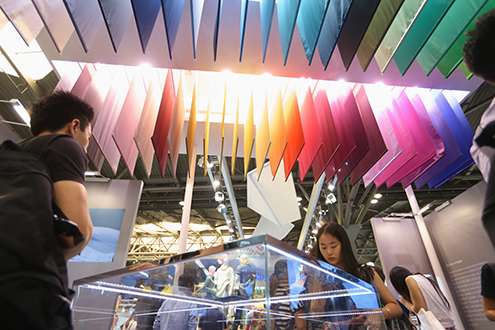 with the concept of ‘sensing’ by looking beyond knitwear and reaching further into the world of what inspires us, exploring a multitude of creative and expressive techniques that combine to make a rich display that looks at denim in a whole new light. The idea of using denim came about because as a very traditional and historically casual fabric it offered the ability to challenge some international leading designers to look at it in a totally new, more glamorous and creative way.
with the concept of ‘sensing’ by looking beyond knitwear and reaching further into the world of what inspires us, exploring a multitude of creative and expressive techniques that combine to make a rich display that looks at denim in a whole new light. The idea of using denim came about because as a very traditional and historically casual fabric it offered the ability to challenge some international leading designers to look at it in a totally new, more glamorous and creative way.
New talent – A true showcase of creativity
The graduates’ work from Nottingham Trent University was on display within the ‘What’s In’ area. The garments and fabrics exhibited were created by students working in collaboration to develop designs of fabrics and garments for the emerging trends and concepts using yarns from a variety of spinners. ‘What’s In’ also showcased a range of garments that have been developed through student sponsorship and live projects with spinners throughout the year.
These sponsorships have evolved after many years of the successful collaborations with Spinexpo. The University also had its own area where more work from the students could be seen.
A number of events took place during the 24th session, starting with a presentation of Mohair South Africa that launched its branding at the show. South Africa is driving global mohair production to new heights, backed up by a growing interest in fashion for the fibre. South Africa is home to the largest mohair handling and marketing facility in the world with over 50% of all mohair produced originating from the angora goat farms on the beautiful plains of the Karoo in South Africa.
A seminar titled ‘International Cashmere Industry Development’, organised by Xuerun Cashmere Products spoke of the healthy and sustainable development of the cashmere industry, comprehensive analysis of the current status of cashmere and an in-depth analysis of Chinese cashmere products market, quality status and rebreeding of the original cashmere goats.
Woolmark Company celebrated ‘50 years of the Woolmark Brand’ and the logo’s purpose of acting as an independent quality assurance of every product it adorns. The company has gained its reputation as being the global authority for quality woollen products, developing close relations with the fashion world and its rich tradition of nurturing fresh talent within the industry. New seasonal guide to the best wool trends and products, created to inspire and inform fashion and textile professionals regarding the infinite potential of merino wool was unveiled on the occasion.
The next session of Spinexpo will return to the Shanghai World Expo
Exhibition & Convention Center from February 3 to 5, 2015.



